The purpose of this blog is to show a simple approach to apiary hygiene for hobby beekeepers. This includes some suggested housekeeping practices, equipment hygiene and bee husbandry disciplines, which hobby beekeepers may find useful.
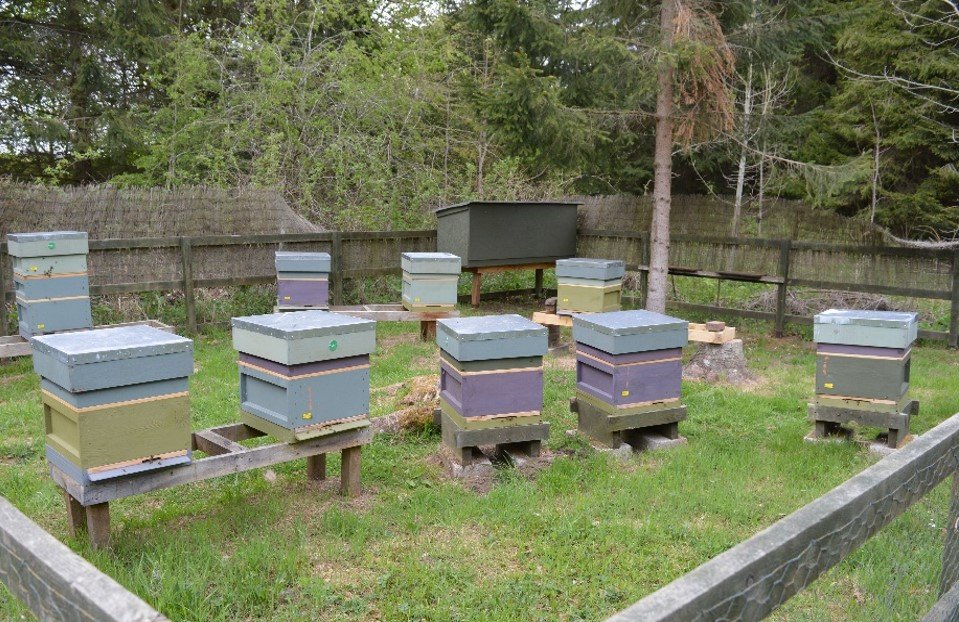
Good Housekeeping
Keeping the apiary clean and tidy is key to apiary hygiene and includes: –
- Being able to clean hands and tools between hives – to avoid cross contamination of disease between hives
- Having somewhere to put brace comb and wax – so it does not end up on the ground, where it can attract pests
- Having somewhere to put discarded wrappers or debris – to keep the apiary tidy
- Providing somewhere to put disposable gloves – for recycling
- Keeping vegetation down around and under hives – to reduce harbour areas for pests and disease and make it easy to tidy up debris.
What equipment do I take into the apiary?
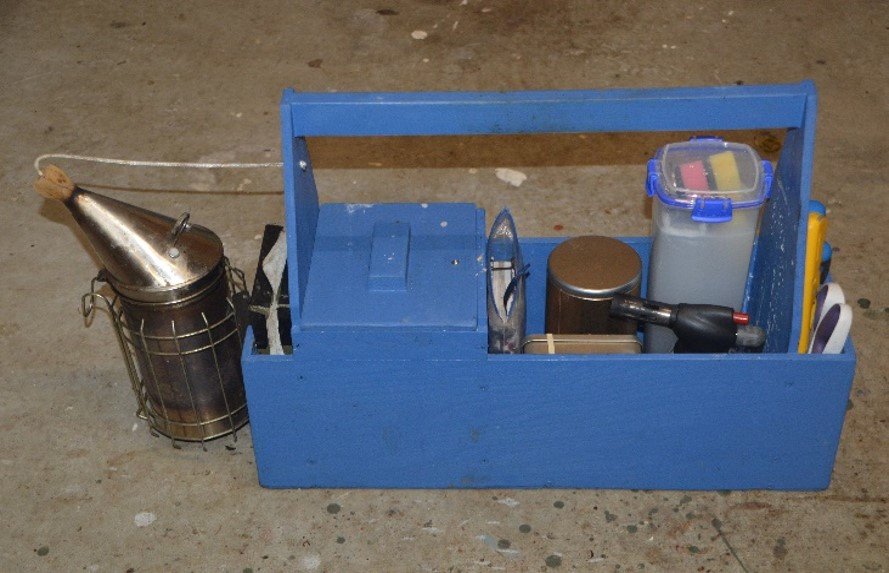
Along with my homemade hive caddy, I take three plastic boxes. The taller one is a plastic bin, fitted with a homemade wooden top, used for rubbish. The smaller one is a plastic tub for collecting used disposable gloves, for recycling. The other is my wax tub, for collecting brace comb.
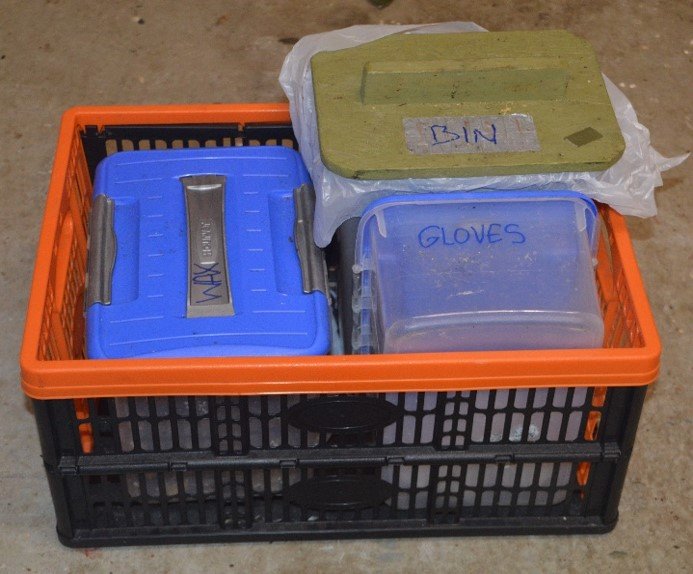
In my hive caddy, I have a plastic spaghetti tub. This is filled with a 1 to 5 solution of cleaning soda and water. My hive tools are kept in this container allowing tools to be washed or changed between hive inspections. A piece of foam is glued in the bottom to prevent the tools from cracking the base when they are dropped in. (yes, that actually happened!). A couple of scotchbrite pads are kept in there too to help with removing propolis.
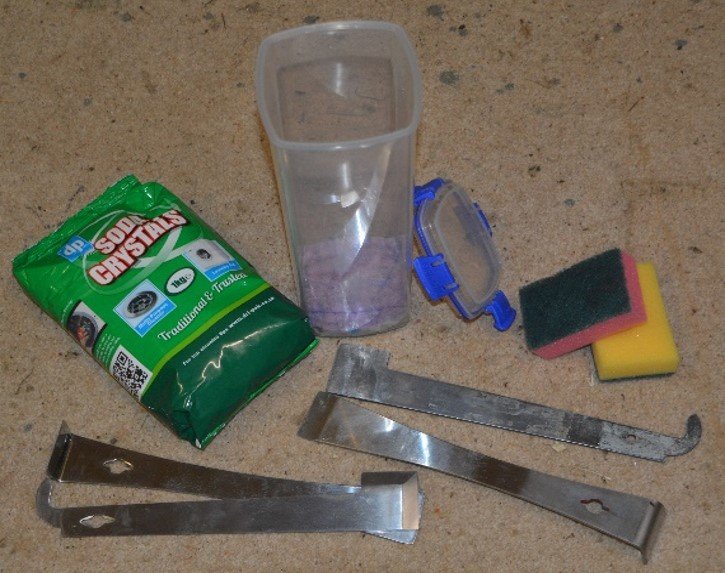
Other equipment taken into the apiary in my hive caddy includes: –
- Smoker – Masking tape is used on the bellows, which can be removed when it is dirty. The lit smoker is also a useful place to dispose of small pieces of hive debris.
- Gloves Tin – My preference is disposable powder free Vinyl medical gloves. I use a recycling service through TerraCycle UK Ltd which provide a disposable gloves recycling service.
- Small Blow Torch – Used to light the smoker but also useful for sterilising tools, tweezers and woodwork.
- Smoker Fuel – I mostly use untreated wood shavings or other natural materials, like pine needles, pinecones and twigs. I avoid cardboard, sisal string or hessian sacking, because of the chemicals they are impregnated with.
- Log book – This small bag contains my journal, as well as my phone/camera, marking pen and laminated emergency contact card (with post code, grid reference and what3words location)
- Bits Tin – Includes: cocktail sticks, tweezers, antihistamine tablets, matchsticks, marking kit, grafting tools, queen cage and x3 reading glasses.
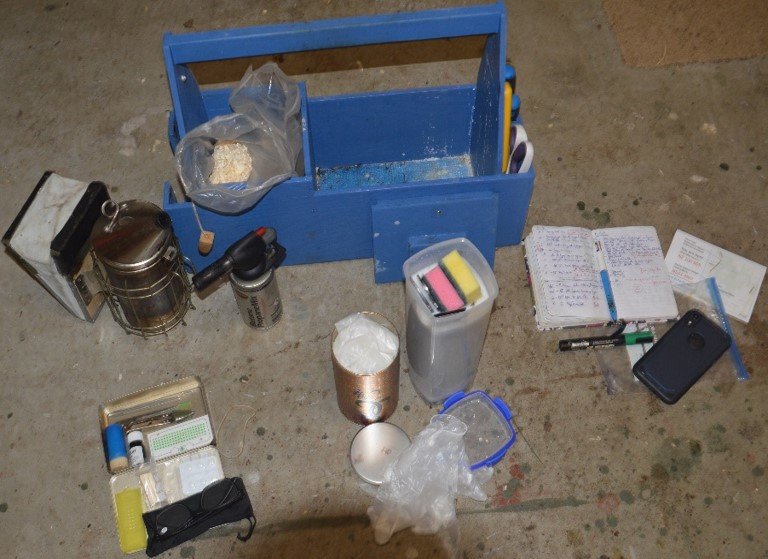
Equipment Sterilisation Regime
Some of the pathogens which effect honeybees can be brought into an apiary on equipment. For example, the notifiable disease American Foul Brood is known to be able to survive for years on used beekeeping equipment.
Some simple disciplines can prevent this, including: –
- Using new beekeeping equipment in the apiary, where possible
- Annual sterilisation of hive parts, like brood bodies, floors and queen excluders
- Quarantine and sterilisation of second-hand equipment before bringing into the apiary
- Retiring equipment when it becomes difficult to clean
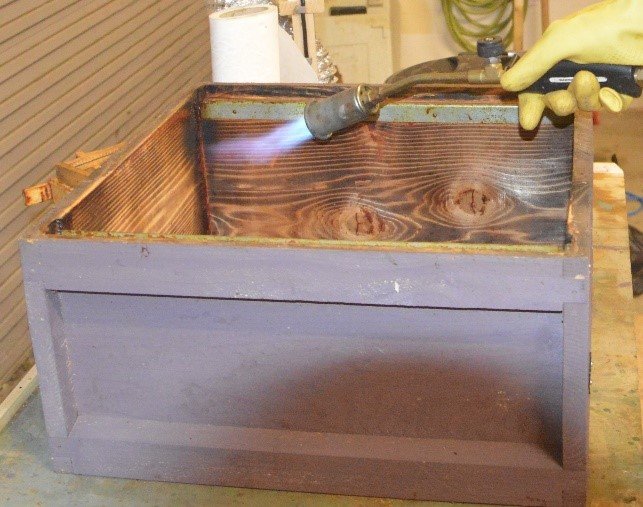
Click here to see our blog on equipment sterilisation.
Comb Replacement Strategy
Brood comb is the place that pests and diseases have the greatest opportunity to build-up over time, so a key apiary hygiene strategy is to replace brood comb on a regular basis. In their leaflet “Replacing old comb”, The national bee unit recommend at least every three years. Jason Learner of the national bee unit also has a good article “The need to change comb”, which can be downloaded from the NBU website, click here.
Others recommend the removal of all brood from every colony in an apiary, around early July, every year. Ralph Büchler described this approach in detail in his presentation at the 2019 honey show. Click here to see the video of his presentation on Youtube.
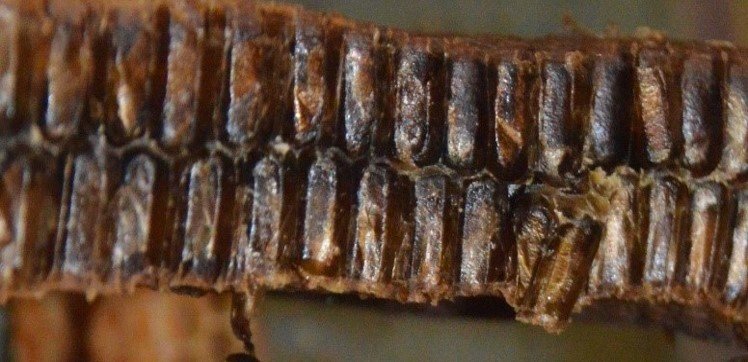
Click here to see our blog on assessing brood comb during the process of cleaning and sterilsation.
What comb replacement strategies can be used?
There are a number of comb replacement startegies which can be used by the hobby beekeeper. Including:-
- Adhoc Frame Removal – In this method the darkest frames are moved to the outside edge of the brood nest and removed when the nest contracts in size. It is a slow and unreliable way of ensuring comb is always less than three years old.
- Bailey Comb Change – This is a recognised bio-technical method of dealing with some of the less serious brood issues. It can also be used to replace comb in a systematic way in a healthy colony. A benefit of this approach is that no brood is lost during the process. The NBU article by Jason Learner also gives a description of the Bailey Comb Change.
- Shook Swarm – In this approach all of the bees are shaken into a new hive, with sterilised comb or foundation. The brood is lost but it is fast way of getting a colony onto fresh comb. Click here to see the national bee unit leaflet on shook swarming.
Which method the hobby beekeeper uses is less important than having an approach and building it into the beekeeping calendar. It is also worth considering that the biggest impact on apiary hygiene will be achieved by carrying out comb replacement on all hives in the apiary at the same time.
Hygienic Bee Husbandry
Avoiding cross-contamination between bees and comb, across apiaries and between colonies within an apiary, is also important to maintaining good apiary hygiene.
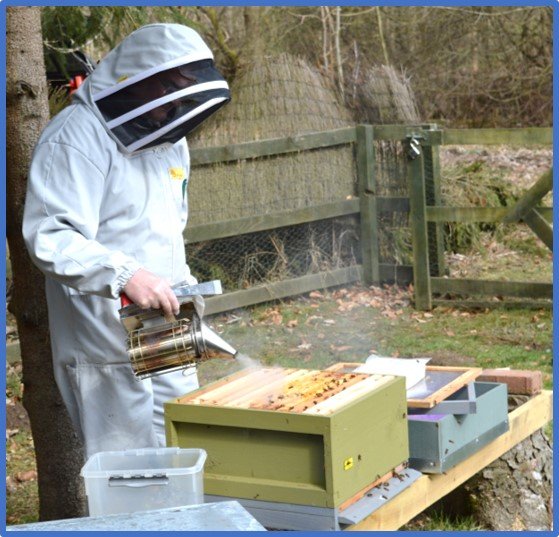
Some simple disciplines to support this include: –
- Avoid drifting and robbing – this can be achieved by pointing the hives in the apiary in different directions and keeping entrances small.
- React quickly – if a colony shows signs of issues, carry out one of the recognised bio-technical or approved treatments before it has a chance to affect other colonies. Also consider treating the other colonies in the apiary.
- Avoid bringing in bees from other apiaries – when this cannot be avoided, quarantine them.
- Don’t move frames between colonies – it can be tempting to “balance up” colonies in an apiary but as a hobby beekeeper it can be better to keep strong colonies strong and fix the problem with the weak colony.
- Raise your own Queens – having the aim of being self-sufficient in bees and queens reduces the risk of introducing disease into an apiary.
- Buy local bees – local bees will be more adapted to the local conditions and they reduce the risk of the transfer of diseases and pests from other countries or counties.
- Select for hygienic behaviour – when selecting which colonies to produce queens or nucs from, choose the one which is the healthiest.
What does it look like in the apiary?
This photo, provided by Master Beekeeper Stuart Roberts, shows the equipment set up on a shelf in my apiary ready to inspect 10 hives.
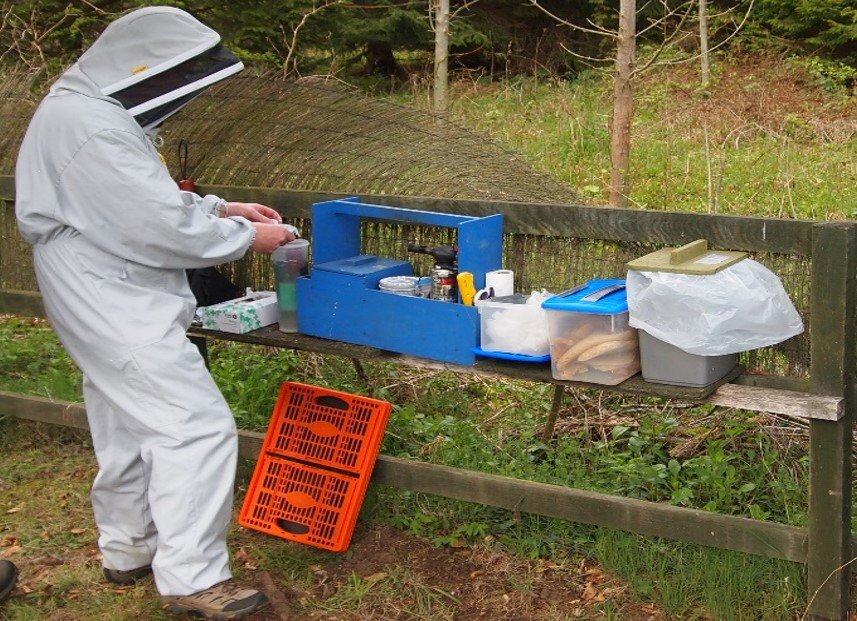
Simple Apiary Hygiene Summary
The purpose of this blog is to show a simple approach to apiary hygiene for hobby beekeepers. This included some suggested housekeeping practices, equipment hygiene and bee husbandry disciplines, which hobby beekeepers may find useful.
With some simple equipment and good practices hobby beekeepers can achieve a high standard of apiary hygiene, by making it part of their beekeeping routine. The aim is not to be brilliant at one aspect of it but to make many small improvements across all the aspects of apiary hygiene.
If you have found this useful please share with others who will be interested. If you would like to receive future posts, please subscribe on the homepage.

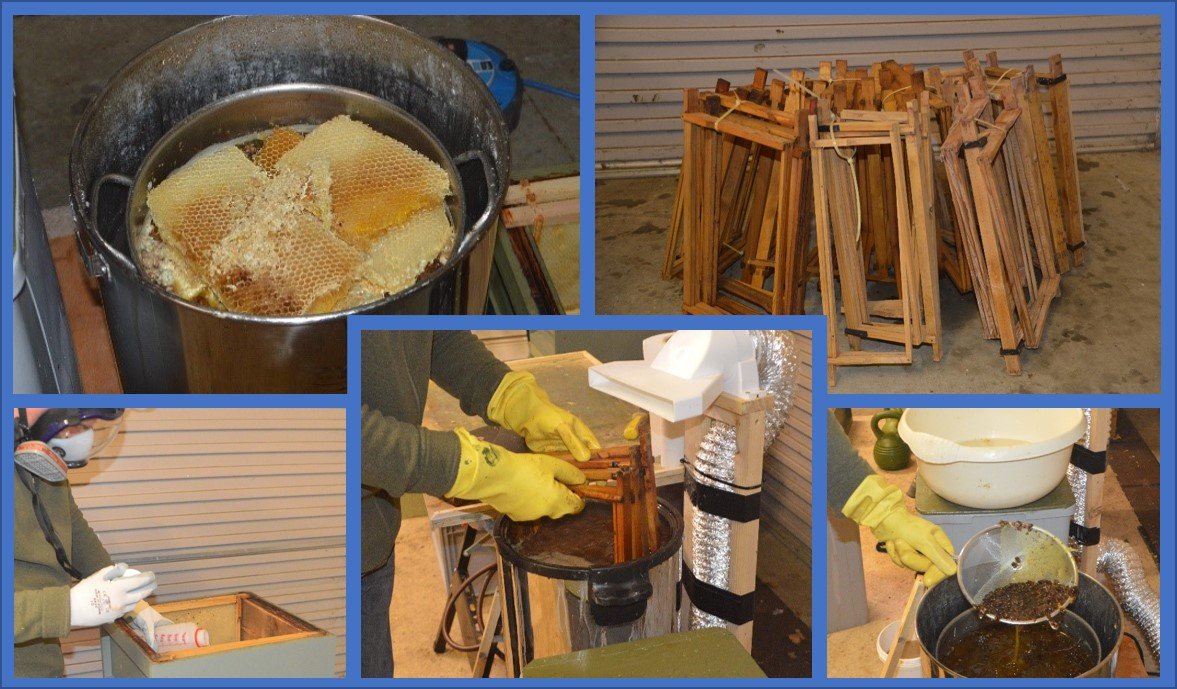
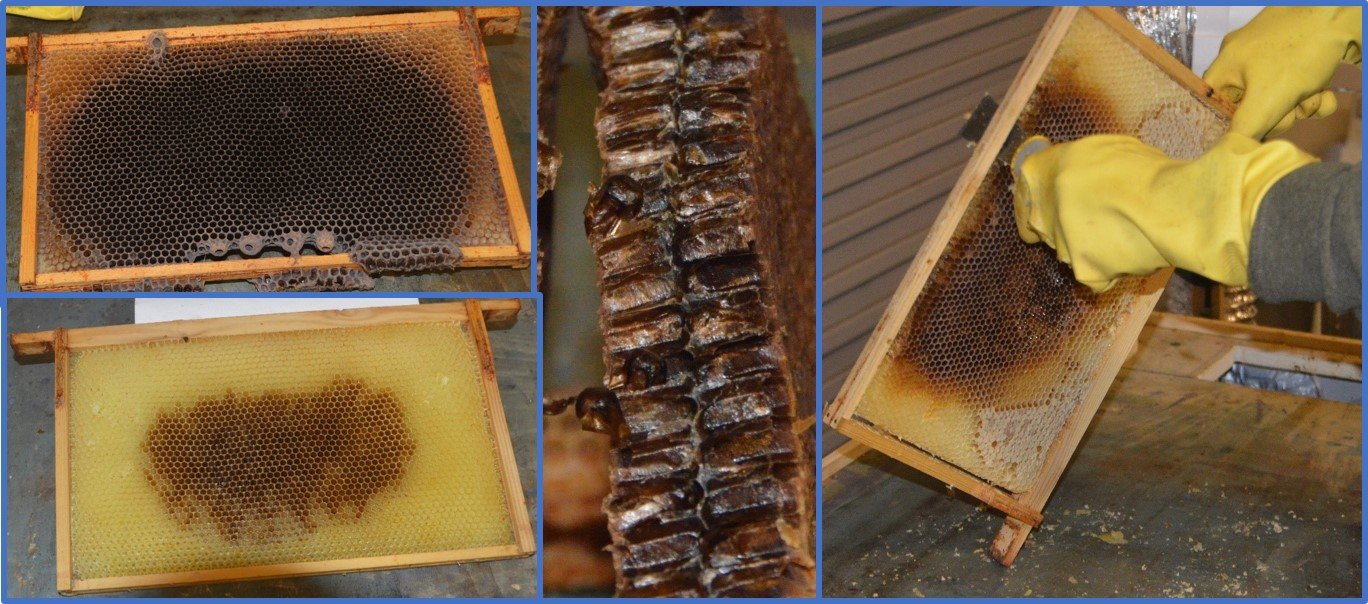
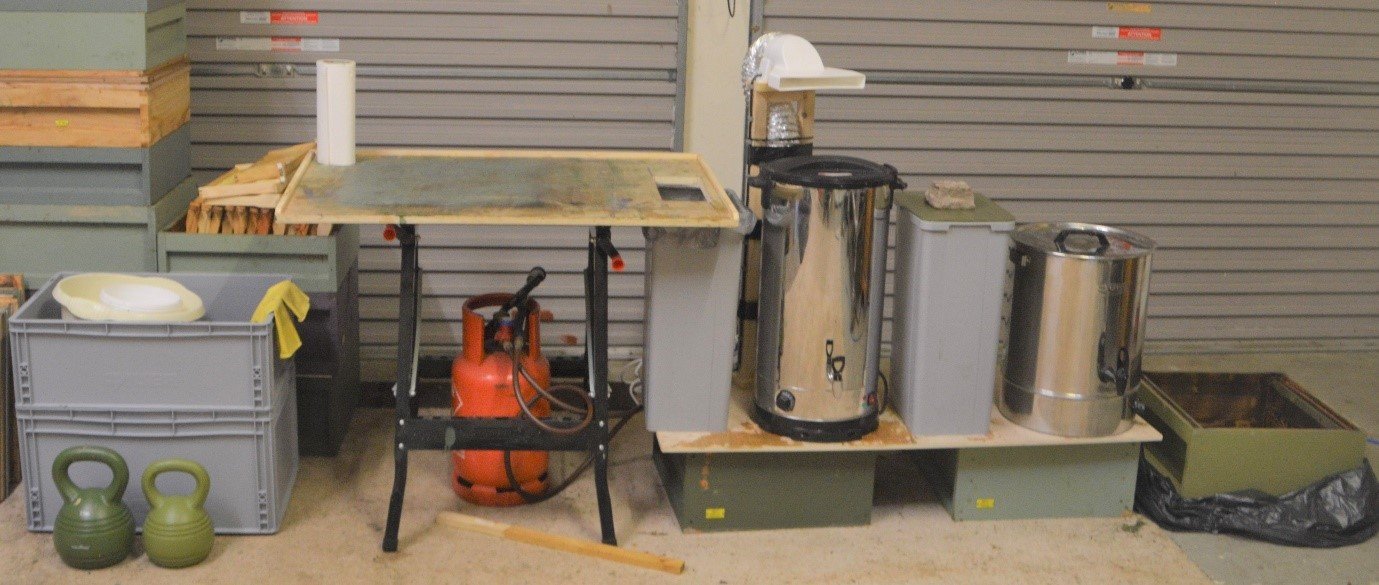
Yep once again a fantastic article and very easy to follow and understand.
I love the way this blog is so visual – this really helps.
I want to share this 1000 times .
Thanks again Ian.
Really great job of making clear understanding, Organized and clean what more can we ask for brings about healthy bees and a happy yard. Thanks.